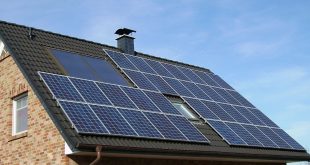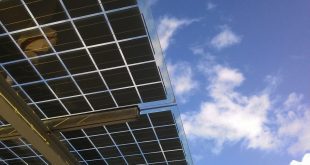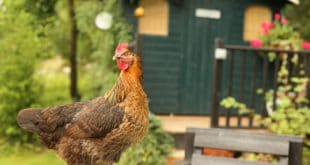By Rex Graham
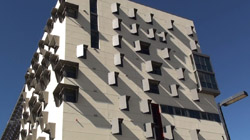 “Wind scoops” pull Pacific breezes into the energy-efficient rooms in UC San Diego’s newest student apartments, cooling them the old-fashioned way in buildings aligned to capitalize on wind and solar rays. Non-potable “recycled” water nourishes native outdoor plants through an efficient drip-irrigation system. The apartments’ plaster, paving, carpet and metal wall studs are made from recycled material, and the residents of the North Campus Housing Phase II project will bathe with water heated by sunlight instead of natural gas or electricity.
“Wind scoops” pull Pacific breezes into the energy-efficient rooms in UC San Diego’s newest student apartments, cooling them the old-fashioned way in buildings aligned to capitalize on wind and solar rays. Non-potable “recycled” water nourishes native outdoor plants through an efficient drip-irrigation system. The apartments’ plaster, paving, carpet and metal wall studs are made from recycled material, and the residents of the North Campus Housing Phase II project will bathe with water heated by sunlight instead of natural gas or electricity.
Welcome to UC San Diego’s newest on-campus dwelling, which will be home to 807 transfer students enrolling for fall 2011 classes. The rooms are affordable, full of million-dollar views and energy-efficient green features, wired with broadband Internet, close to tasty organic-food dining, and a short stroll to nearby world-class surfing at Black’s Beach. Shade trees and shaded balconies, spacious stairs and walkways, and meeting and living rooms illuminated with natural light will provide residents with inviting spaces to deconstruct an econ midterm, discuss a campus concert, or plan the weekend.
“Who would have imagined a few years ago how stylish and cool an ultra-sustainable student apartment development could be?” said Mark Cunningham, executive director of Housing, Dining and Hospitality at UC San Diego. “Our Village II apartments are not just an outgrowth of the campus’ well known commitment to sustainable operations, but they also will immerse students in a personal lifestyle that’s environmentally sustainable, which they will hopefully emulate the rest of their lives.”
The 267,000 gross-square-foot, Village II project, adjacent to the similar-sized Village I apartments, has transformed UC San Diego’s north entrance into a modern architectural statement that puts OMG on the lips of visiting students and their parents.
No State of California money was used in the project: external financing will be via UC issued bonds to be repaid by student housing fees, and from UC San Diego Housing reserves.
Don’t skateboard? No problem; bicycle parking is inside the building and bus stops are closer than the next hole in disc golf course, making on-campus transportation easy, convenient, inexpensive and energy efficient.
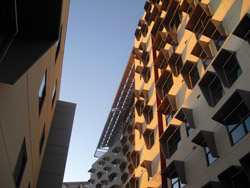 “We will now have more than 3,000 students living in a beautiful section of the campus that a few years ago had no housing,” said Gary C. Matthews, vice chancellor for Resource Management and Planning. “By living in such extreme-green apartments, eating in dining halls that use sustainable practices, and using mass transit and other transportation alternatives, students living in the Village II apartments will be contributing in a very significant way toward the campus’ goal of reducing its carbon footprint.”
“We will now have more than 3,000 students living in a beautiful section of the campus that a few years ago had no housing,” said Gary C. Matthews, vice chancellor for Resource Management and Planning. “By living in such extreme-green apartments, eating in dining halls that use sustainable practices, and using mass transit and other transportation alternatives, students living in the Village II apartments will be contributing in a very significant way toward the campus’ goal of reducing its carbon footprint.”
Each of the 146 five- and six-bed room apartments will have a living-dining-kitchen area, shared bathrooms with low-flow fixtures and a storage area. The project includes vending, laundry, mail areas and administrative offices. Windows will maximize the use of ambient outdoor light and the outside lights used after dark are low-energy LEDs. Occupancy sensors within apartments shut off lights and appliances when rooms are unoccupied.
Even the construction of the project by Clark Design/Build of California was ultra-sustainable. The company, a subsidiary of Clark Construction Group, worked closely with the project architect and the university’s Facilities Design and Construction Department, taking such steps as using recycled and regionally produced building materials and practices that helped the project garner sufficient green points for a LEED (Leadership in Energy & Environmental Design) Gold application with the U.S. Green Building Council. In addition, main structural-support walls were moved from the exterior of the building to interior spaces, a change that promotes the natural flow of ventilating air.
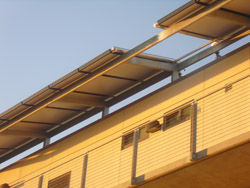 “Despite the complexity of reconciling these multiple sustainable design and construction features, the entire project was completed nearly 11 weeks ahead of schedule due to our close collaboration with UC San Diego, the designer Carrier Johnson + Culture, and our subcontractors,” said Kevin Legge, senior project manager with Clark Design/Build of California. “This project has been a benchmark for us as design and construction professionals. We will apply the lessons learned here on many future projects.”
“Despite the complexity of reconciling these multiple sustainable design and construction features, the entire project was completed nearly 11 weeks ahead of schedule due to our close collaboration with UC San Diego, the designer Carrier Johnson + Culture, and our subcontractors,” said Kevin Legge, senior project manager with Clark Design/Build of California. “This project has been a benchmark for us as design and construction professionals. We will apply the lessons learned here on many future projects.”
The system’s solar collectors, mounted on various roofs and canopies above exterior walkways, absorb solar energy, transferring it to a non-potable fluid that flows down to tanks where heat exchangers warm the separate potable water system. Residents draw the solar-heated water for showers and baths with the turn of a faucet. To top it off, UC San Diego will benefit from a cash rebate up to $500,000, the maximum rebate under the California Solar Initiative’s Thermal program for the 300-kilowatt solar water-heating system installed by Aztec Solar.
“The most advanced feature of the Village II project is the solar water-heating system, which is one of the largest, if not the largest, installation at a North American university,” said Ed Murray, president and CEO of Aztec Solar. “Our company has served agribusiness companies, hotels, restaurants, and hospitals, and we’re thrilled to install such a large project at UC San Diego. We look forward to future green projects on the campus.”
The campus goal is to house 50 percent of all students, and to meet that goal it has added more beds in the past nine years than during the previous 41 years. The university currently houses 41percent percent of all students and will soon to be at 45 percent with the completion of Village II and the soon-to-be-completed Revelle College Apartments and Muir College Apartments.
 Alternative Energy HQ solar power for homes, wind energy, and bio fuel issues
Alternative Energy HQ solar power for homes, wind energy, and bio fuel issues


